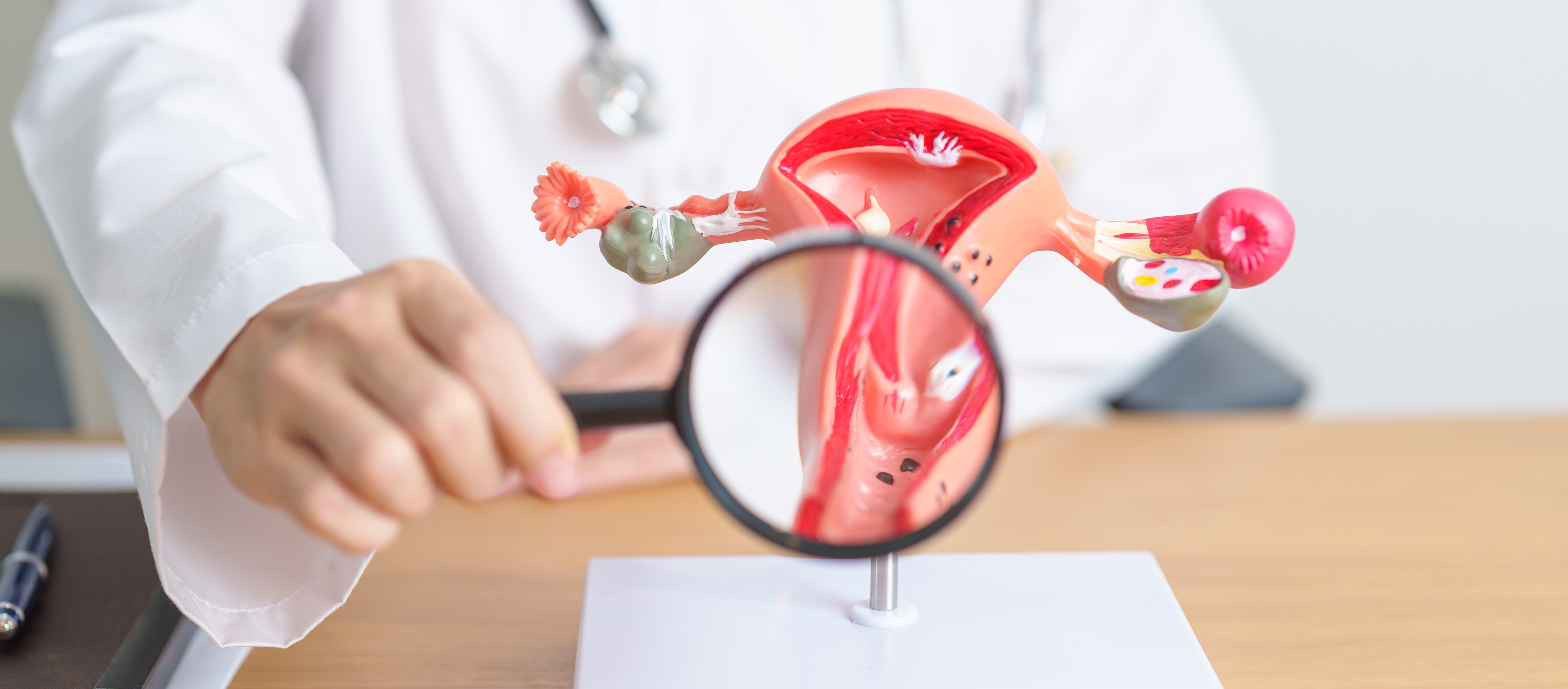Breast Cancer - Symptoms, Diagnosis & Treatment
Written By: Dr. Rita Daaboul
Updated On:December 20, 2023

What is Breast Cancer?
Breast cancer is one of the leading cancers among women. When breast cells divide & grow in an unusual, uncontrolled way, this signifies the beginning of breast cancer. Many breast cancers start in the ducts – the tubes that carry breast milk to the nipple.
Other breast cancers begin in the lobules - glands that produce milk for breastfeeding. Breast cancer is mostly seen in older women, with research suggesting 80% of breast cancers appear in those over 50 years. As we age, the risk of breast cancer increases. However, research suggests that breast cancer incidence in the UAE – among Arab women - is higher at a younger age. Breast lumps are not the only symptom of breast cancer.
Breast Cancer In Men
Men can also contract breast cancer, but it is rare. Most men with breast cancer are over 60 years of age. The chances of successful treatment are higher when breast cancer is diagnosed early, with a better chances of successful treatment. It’s crucial to check the breasts regularly & visit your nearest Medcare facility if you notice any changes.
Causes of Breast Cancer
There isn’t a single cause of breast cancer, rather many factors that doctors believe contribute to it. It is widely understood that breast cancer is caused by a combination of genetic factors, environmental factors & lifestyle choices.
Some of these breast cancer-contributing factors include:
- Age: Breast cancer is most commonly seen in women over 50.
- When menstruation begins: There’s some evidence to suggest women who start their periods at an early age – under 12 – have a slightly increased risk of breast cancer.
- Time of Menopause: Women who go through menopause later than average (the average age is 52), are seen to have slightly increased breast cancer risk.
- Breast Density: Women with more breast tissue than fat have a higher risk of contracting breast cancer. Breast density is measured using a mammogram.
- Breast Conditions: Some women with non-cancerous breast conditions, such as atypical hyperplasia (when cells lining the breast ducts or lobules increase in number & develop an unusual pattern or shape) or lobular neoplasia (an increase in the number of cells contained in the lobules, alongside a change in their appearance & behaviour) have increased risk of breast cancer.
- Family History: If a close relative has breast cancer, or if there is a significant family history of breast cancer, the risk can be heightened, but evidence suggests this is minimal.
- Contraception: Those taking the combined contraceptive pill have displayed a slightly increased risk, but that risk disappears a few years after stopping taking it.
- Hormone Replacement Therapy: HRT increases the risk of breast cancer while taking it & for a few years after stopping.
Lifestyle Factors
- Alcohol: Regularly drinking alcohol is associated with a higher breast cancer risk.
- Weight: The risk of developing breast cancer increases if you are overweight or obese after menopause.
- Exercise: Sedentary lifestyles are a contributory factor in many cancers.
- Smoking: Growing evidence suggests smoking slightly increases breast cancer risk.
When to see a doctor for Breast Cancer
Remember that while breast pain is not necessarily a sign of breast cancer, any sign of a lump or swelling, or noticeable change in breast shape or size, is worth a visit to your local Medcare hospital or medical centre for a check-up. Our experts are trained to spot the signs & symptoms of breast cancer, & can rapidly offer tests, advice & appropriate courses of treatment if & as required.
What are the symptoms of Breast Cancer?
Pain in the breast is not usually considered a sign of breast cancer – while being mindful of breast pain that is significant & sustained is key, benign (non-cancer related) breast conditions are common. Noticing unusual changes in the breasts doesn’t necessarily lead to breast cancer. Most breast changes are not cancerous.
Symptoms of Breast Cancer may include:
- Breast lumps or swelling, also often seen in the upper chest or armpit – often the lump can be felt, but not seen.
- Skin changes, such as puckering or dimpling.
- Breast colour changes – the breast may look red or inflamed.
- Changes in the nipple - it may be pulled in (inverted), for example, as well as a rash or crusting around the nipple.
- Unusual discharge from either nipple.
- Size or shape changes in the breast.
We recommend getting checked by your Medcare professional regularly. If you feel you have symptoms, contact us today for an appointment with one of Medcare’s specialist team.
Diagnosing Breast Cancer
While breast screening can be a normal part of any health or insurance or work-related medical check-up, it is recommended that women over 50 undergo a breast screening at least every two years.
Breast Screening
Many experts agree that regular breast screening helps in early identification of breast cancer – & the earlier it’s discovered, the higher the chances of successful treatment & survival. Early detection also reduces the need for mastectomy (breast removal) or chemotherapy treatment. If you’re concerned, you might have breast cancer, make an appointment with Medcare to identify what’s causing your sympto
Tests For Breast Cancer
Diagnosis of breast cancer involves a variety of tests & procedures, including:
- A mammogram. An X-ray of the breast commonly used to screen for breast cancer. If any abnormality is found during a screening mammogram, a diagnostic mammogram may be recommended to further evaluate that abnormality.
- Breast examination. The doctor checks the breasts & armpit lymph nodes, feeling for lumps & any other abnormalities.
- Breast ultrasound – involves using sound waves to generate images from within the body. Ultrasound can help determine whether a breast lump is a solid mass or a fluid-filled cyst.
- Breast tissue biopsy – the benchmark test for breast cancer diagnosis, breast tissue is examined by a laboratory for expert testing. A biopsy can also help ascertain the types of cells causing cancer & the grade.
- Breast magnetic resonance imaging (MRI). An MRI involves using magnetism & radio waves to create images of the breast’s interior.
Staging Breast Cancer
On diagnosis of breast cancer, the extent (stage) of cancer must be established in order to determine the prognosis & create a treatment plan. Full information regarding the stage of cancer may not be available until after breast cancer surgery.
Tests employed in staging breast cancer include:
- Blood tests.
- A Mammogram of the other breast, to ascertain there is also cancer there.
- A breast MRI.
- Bone scanning.
- A computerized tomography (CT) scan.
- A positron emission tomography (PET) scan.
Medcare’s professional health experts will select the appropriate tests based on patient circumstances, taking into account any new symptoms. Breast cancer stages are designated from 0 to IV. Stage 0 suggests cancer that is non-invasive or contained within the milk ducts. Stage IV breast cancer - metastatic breast cancer - is indicative of cancer that has spread.
Breast cancer Treatment
You may be offered one type of treatment or a combination of treatments. The type & combination of treatment offered depend on the cancer diagnosis & stage. Your Medcare health professionals will discuss which options are available & right for you.
Some of the main treatments for breast cancer include:
- Surgery
- Radiotherapy
- Chemotherapy
- Hormone therapy
- Targeted therapy
Choosing breast cancer treatments
Your Medcare team will consider:
- Stage & grade of cancer
- Your general health
- Whether you have undergone menopause
Breast Cancer Surgery
Surgery is commonly the first treatment for breast cancer. Surgery type will vary, depending on breast cancer type. After surgery, chemotherapy, radiotherapy or, in certain cases, hormone or targeted therapies will be offered, again depending on the type of breast cancer. Sometimes, chemotherapy or hormone therapy will be offered first of all. Breast cancer surgery can involve:
- Breast-conserving surgery, which involves removal of a tumor.
- Mastectomy, where the whole breast is removed.
Following mastectomy, reconstructive surgery is often undertaken to reconstruct & replace the removed breast. Studies reveal that breast-conserving surgery followed by radiotherapy is as successful as total mastectomy in treating early-stage breast cancer.
Breast-Conserving Surgery: Breast-conserving surgery encompasses lumpectomy or wide local excision, (where the tumor & some surrounding breast tissue is removed), to partial mastectomy or quadrantectomy, where up to a quarter of the breast is removed. If breast-conserving surgery is performed, the volume of breast tissue removed will depend on:
- The type of cancer.
- The size & location of the tumor.
- The volume of tissue surrounding the tumor that needs to be removed.
- Breast size.
The surgeon will always remove an area of healthy breast tissue around the tumour, which will be tested for traces of cancer. If there's no cancer found in the healthy surrounding tissue sample, there's less chance of it returning. If cancer cells are discovered in the surrounding tissue, more breast tissue may need to be removed. Following breast-conserving surgery, radiotherapy is commonly administered to destroy any remaining cancer cells.
Mastectomy: A mastectomy involves removing the entire breast, including the nipple.
Breast Reconstruction Following Mastectomy: Breast reconstruction is special surgery to make a new breast, which mirrors the remaining breast as closely as possible. It is performed either by breast implant or by using tissue from another part of the body.
Lymph Node Surgery: To ascertain if the cancer has spread, a sentinel lymph node biopsy may be done. Sentinel lymph nodes, found under the arms, are the first lymph nodes that cancer cells reach if they spread. If cancer cells are discovered in the sentinel nodes, further surgery to remove more lymph nodes from under your arm may be required.
Radiotherapy: Radiotherapy involves delivering controlled doses of radiation to kill cancer cells. Usually, radiotherapy is applied after surgery, along with chemotherapy to kill any remaining cancer cells.
Four types of radiotherapy may be used in breast cancer treatment:
- Breast Radiotherapy following breast-conserving surgery, radiation is applied to the whole of the remaining breast.
- Chest-Wall Radiotherapy applied after a mastectomy.
- Breast Boost high-dose radiotherapy in the area where the cancer was.
- Lymph Node Radiotherapy is aimed at the armpit & the inner chest to kill any remaining lymph node cancer.
Chemotherapy: Chemotherapy provides anti-cancer (cytotoxic) medicine to kill cancer cells via a drip, into the arm. It's usually used after surgery to destroy cancer cells that have not been removed, but sometimes before surgery to reduce large tumors.
Hormone Treatment: Certain breast cancers are stimulated by the hormones oestrogen or progesterone. These are known as hormone receptor-positive cancers. Hormone therapy lowers oestrogen or progesterone levels, stopping their effects. Hormone therapy is often given after surgery & chemotherapy, but sometimes before surgery to help shrink a tumor - making it easier to remove. Hormone therapy may be the only treatment recommended for breast cancer if your general health prevents you from having surgery, chemotherapy or radiotherapy.
Targeted Therapies: Targeted therapies alter cell function, helping stop cancers from growing & spreading. Not all breast cancers can be treated with targeted therapies. Some targeted therapies are given via drip into a vein. Others come as tablets.
Complementary Therapies: Complementary therapies may improve physical & emotional wellbeing. Often offered alongside conventional treatments, they include:
- Stress reduction techniques, such as breathing exercises
- Massage
- Aromatherapy
- Acupuncture
Please speak to your Medcare professional about any complementary therapy to ensure it does not interfere with your conventional treatment.
Secondary Breast Cancer: While most breast cancers are discovered at an early stage, a small number of women discover breast cancer after it has metastasized - spread to other parts of the body. This so-called secondary cancer, also called "advanced" or "metastatic" cancer, is incurable. In this case, treatment may be different, to achieve remission, where cancer shrinks or disappears.
Chemotherapy for secondary Breast Cancer: In cases when breast cancer has spread beyond the breast & lymph nodes, chemotherapy will not cure it, but may shrink the tumor, relieve symptoms & help extend life.
Risk Factors of Breast Cancer?
A combination of breast size, personal medical history, & family medical history can put an individual at risk of developing breast cancer. Doctors advise at-home breast checking as part of a woman’s personal-care routine. Detecting a symptom early can be a critical part of recovery.
Risk factors for breast cancers may include:
- Age
- Genetic mutations
- Reproductive history
- Breast density
- A personal history of breast cancer
- Family history of breast or ovarian cancer
- Previous radiation therapy treatment
On top of these unavoidable risk factors, there are many lifestyle risk factors, which can be avoided, including:
- Lack of Exercise: A small amount of daily exercise increases overall health & helps avoid cancers.
- Weight: Being overweight or obese after menopause increases risk.
- Taking hormones
- Drinking Alcohol: Risk for breast cancer increases with greater alcohol consumption.
- Smoking: The risk increases slightly among those who smoke.
- Chemicals: Exposure to toxic chemicals.
- Hormonal Changes: Such as those brought on by night shift working may increase breast cancer risk.
Breast Cancer Complications
In cases of advanced breast cancer, there are a number of complications relating to pain in the
- Bones
- Lungs
- Liver
- Brain
There can also be treatment-related complications.
Cancer-Related Pain: Cancer tumors can put pressure on organs, nerves, & bones, causing significant escalating intractable pain.
Bone Complications: Breast cancer often spreads to the bones, which can cause significant pain. Breast cancer that spreads to the bone can cause the following complications:
- Bone pain resorption can cause bone thinning & weakening, often leading to fractures.
- Spinal compression, cancer cells in or near the spine can put pressure on the spinal cord & adjacent nerves, bringing pain to the back or neck, numbness or tingling, & difficulty walking.
- Hypercalcemia is a bone complication which means elevated levels of calcium in the blood. This can cause: Kidney stones, Kidney failure, Irregular heartbeat, Neurological problems including confusion, dementia or coma.
Lung Complications: Breast cancer that has spread to the lungs doesn’t always lead to symptoms & complications, but may cause:
- Shortness of breath
- Wheezing
- Chest pain
- Continual, persistent cough
- Effusion - cancer cells producing fluid that surrounds your lungs
Liver Complications: Around half of those with metastatic breast cancer may have spread to the liver. Early signs include:
- Pain
- Stomach fullness
- Sudden weight loss
- Vomiting
- Jaundice
- Blockage of bile ducts, which help the liver remove waste
Brain Complications: If breast cancer spreads to the brain, it may cause vision, memory, or behavioral problems. Symptoms can include:
- Headaches
- Dizziness
- Nausea
- Vomiting
- Seizures
Cancer Treatment-Related Complications: Cancer treatment means removal of both abnormal & normal cells from the body, so unpleasant side effects are fairly common. Cancer treatments can cause pain, sickness, & hair loss. Chemotherapy treatments may also result in:
- Mouth sores
- Nausea
- Nerve damage
- Diarrhea
Radiation therapy can cause burning pain & scarring, while surgery can be painful & may require significant time for recovery. Removing lymph nodes to check for cancer cells disrupts the flow of lymph fluid. If there aren’t enough lymph nodes to properly drain fluid from a certain part of the body, a form of painful swelling called lymphedema can occur.
Breast Cancer Prevention
While everyone has a certain degree of susceptibility to breast cancer, there are some straightforward lifestyle factors we can all undertake to lessen & avoid the risks, includi
- Diet: Eat a healthy diet, rich in vegetables, fruit & natural, high fibre whole foods. Avoid bad fats, too much red meat & highly processed & junk foods.
- Weight: Maintain healthy weight, especially as you approach old age.
- Chemicals: Avoid toxic chemicals both at home & work.
- Exercise & Activity: Undertaking a regular exercise regime will certainly benefit overall health. Studies show that moderate weekly physical activity reduces the risk of breast cancer by around 20%.
Meet our doctors from the General Surgery department

































